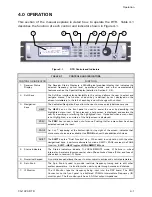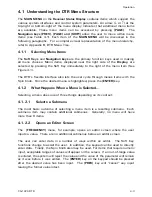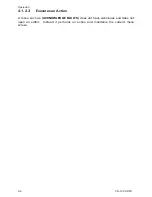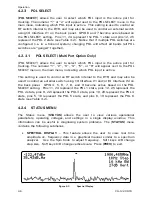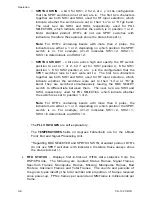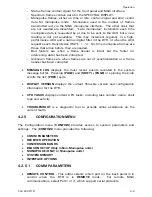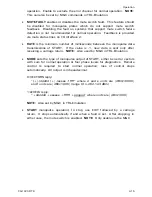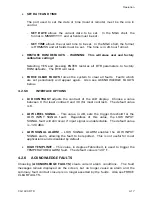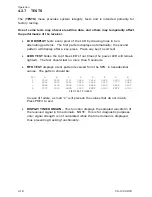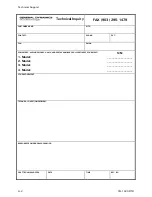
Operation
CG-1220 DTR
4-13
2. FFT Noise - Displays noise density within the selected bandwidth. This
mode is useful when tracking a broadband signal (Video or digital). However
due to FFT processing time the response is slightly slower than that of the
RMS Density
mode process time.
3.
RMS Power – Displays total RMS power measured in the selected
bandwidth. This mode suspends the FFT operation thus decreasing
signal processing time. Changing the selected bandwidth changes
the displayed power measurement. The displayed power level will
increase with broader bandwidth selections.
4.
RMS Density - Displays power level per Hz of bandwidth
thus normalizing the signal measurement. This mode is preferable for
tracking a wideband signal. Displayed power level will be more
constant at different bandwidth selections and slightly faster than
FFT Noise
mode.
4.2.5.3
CONVERSION BANDS*
*Factory default has all conversion bands set to L-Band if no internal BDC is
present in the unit. If an internal BDC is present, factory default contains
information specific to the internal BDC.
The conversion bands can be configured for an external down-conversion device.
This enables the actual beacon frequency to be entered as the tracking frequency
rather than the down-converted L-Band frequency being entered as the tracking
frequency.
For example, if an L-Band DTR is being used to track a 12.0GHz beacon and the
LO of the external device is 10.5GHz, the L-Band frequency at the DTR RF input
would be 1.5GHz. The tracking frequency could be set to 1.5GHz in order to track
this beacon. However, the conversion band could be setup with the external
down-converter’s parameters. This would enable the DTR to be set to a tracking
frequency of 12.0GHz to match the actual frequency of the beacon.
The
[CONVERSION BANDS]
menu describes the downconverter setup and has
various submenus, depending on the number of bands in any particular model.
Each
BAND
menu (1-4) has the following submenus:
BDC GAIN
is
the gain in dB of the down-conversion devicefor this band.
The factory default setting should not be adjusted, as it reflects the BDC
attenuator pair internal to the unit. If utilizing an external down-conversion
device, this should be set to 0.
OSCILLATOR FREQUENCY
is the local oscillator frequency of the down-
conversion device for this band. Factory default is the LO frequency of the
internal BDC and should not be adjusted. If utilizing an external down-
conversion device, this should be set within 1kHz of the external device’s
LO frequency.
Содержание CG-1220
Страница 6: ...vi THIS PAGE INTENTIONALLY LEFT BLANK...
Страница 10: ...Table of Contents x THIS PAGE INTENTIONALLY LEFT BLANK...
Страница 16: ......
Страница 54: ...Maintenance 5 4 CG 1220 DTR THIS PAGE INTENTIONALLY LEFT BLANK...
Страница 56: ...Engineering Drawings 6 2 CG 1220 DTR THIS PAGE INTENTIONALLY LEFT BLANK...
Страница 59: ...Menu Tree APPENDIX B MENU TREE This Appendix contains the menu tree for the DTR CG 1220 DTR B 1...
Страница 65: ...Appendix C DTR Remote M C Protocol CG 6073 Rev R Jun 2012 4 THIS PAGE INTENTIONALLY LEFT BLANK...
Страница 129: ...Appendix C DTR Remote M C Protocol CG 6073 Rev R Jun 2012 68 THIS PAGE INTENTIONALLY LEFT BLANK...
Страница 130: ...Remote M C Protocol C 2 CG 1220 DTR THIS PAGE INTENTIONALLY LEFT BLANK...
Страница 133: ...Acronyms Abbreviations TX Transmit V Volts VAC Volts AC VDC Volts DC VSWR Voltage Standing Wave Ratio CG 1220 DTR D 3...
Страница 134: ...Acronyms Abbreviations D 4 CG 1220 DTR THIS PAGE INTENTIONALLY LEFT BLANK...



